|
SERVICE UPDATES:
Adult Reconstructive (Arthroplasty) Service
The Arthroplasty Service, under the direction of Andrew A. Freiberg, MD, has again had another impressive year with respect to both clinical activities and research. Our Morning Arthroplasty Conference is recognized as one of the best conferences in the MGH training program. In addition, multidisclipinary CAOS (Combined Arthroplasty Oncology Service Rounds) Conference has added greatly to our understanding and capabilities in treating patients with Orthopaedic oncologic problems.
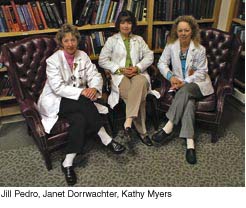 The interest of both our clinicians as well as patients in the MIS 2 incision total hip arthroplasty continues to mount. We have performed over 100 cases, to date, and have submitted articles on our learning curve, our financial analysis of minimally invasive hip surgery, as well the outcome of our first hundred cases. Once again, thank you to the members of the Departments of Nursing, Anesthesia, Radiology, Physical Therapy, Occupational Therapy and Discharge Planning as well as Janet Dorrwachter, RN, our MIS Nurse Coordinator, for their outstanding work in developing this program. This team approach has been an important focal point for surgery and nursing education. I also congratulate Janet M. Dorrwachter, BS, RN; Kathleen M. Myers, MSN, RN, APRN, BC, ONC, and Jill Pedro, MSN, RN, ONC, for their poster this year at the Annual NAON Meeting on Minimally Invasive (MIS) Two Incision Total Hip Replacement: Pre-operative Education and Post-operative Care. The interest of both our clinicians as well as patients in the MIS 2 incision total hip arthroplasty continues to mount. We have performed over 100 cases, to date, and have submitted articles on our learning curve, our financial analysis of minimally invasive hip surgery, as well the outcome of our first hundred cases. Once again, thank you to the members of the Departments of Nursing, Anesthesia, Radiology, Physical Therapy, Occupational Therapy and Discharge Planning as well as Janet Dorrwachter, RN, our MIS Nurse Coordinator, for their outstanding work in developing this program. This team approach has been an important focal point for surgery and nursing education. I also congratulate Janet M. Dorrwachter, BS, RN; Kathleen M. Myers, MSN, RN, APRN, BC, ONC, and Jill Pedro, MSN, RN, ONC, for their poster this year at the Annual NAON Meeting on Minimally Invasive (MIS) Two Incision Total Hip Replacement: Pre-operative Education and Post-operative Care.
The Arthroplasty Service had an outstanding presence at this year’s AAOS and ORS Meetings with twenty-six posters, papers, and exhibits. Many of our faculty members were moderators, symposia chairs and course participants, once again, at our annual program. The Arthroplasty Service also had a spectacular year with respect to peer-review publications, book chapters, and reviews. As part of our educational programs, we also gave numerous national and international lectures in such places as Taiwan, China, Korea, Japan, Italy, and France.
Our Adult Reconstructive Fellowship Training Program continues to be an outstanding one. This fellowship is one of the oldest and most renowned in the field of Arthroplasty and our fellows are drawn to our rich heritage of clinical and research excellence. This year’s Fellows: Jeffrey Geller, MD; James “Hutch” Huddleston, MD; Asit Shah, MD; and John Velyvis have been an outstanding group of trainees. We will miss them as they matriculate to a variety of programs across the country. Dr. Geller will join the academic faculty at Columbia, in New York; Dr. Huddleston will join the academic faculty at Stanford University; Dr. Shah will join a large private practice, the Engelwood Orthopaedic Associates, in his home state of New Jersey; and Dr. Velyvis will work with several of our colleagues and my former fellow, Raj Sinha, MD, in Palm Springs, California, at Desert Orthopaedic Associates.
Our research program in crosslinked polyethylene is thriving in new applications in total knee arthroplasty, shoulder and spine. This year, we will be the first to perform clinical trials and an IRB study to evaluate wear utilizing these materials using a radiosterometric analysis (RSA). These new materials have outstanding wear resistance and, as a result, have few of the liabilities of first generation crosslinked polyethylenes. In addition, we recently developed a constrained acetabular component that, for the first time, allows an increased range of motion, the use of crosslinked polyethylene and provides a powerful constraint to prevent dislocation.
We congratulate Dr. Guoan Li and his team for their outstanding contributions at the Orthopaedic Research Society (ORS) this year with reports on the Kinematics of Knee Arthroplasty and Posterior Stabilized Knee Arthroplasty Using Robotic Technologies, as well as his outstanding ORS symposium on Kinematics of the Knee. Here, he reported some of his newest knee kinematics research as well as unicondylar knee arthroplasty and high flexion data. In addition, Dr. Li has developed an extensive and innovative dual fluoroscopy program to evaluate the clinical performance of a variety of different knee arthroplasty designs with a highly reproducible and accurate kinematic evaluation.
Dr. Freiberg reports, “Our future plans include expanding our clinical practices with an emphasis on state-of-the-art methodologies for primary and revision arthroplasty. In addition, we will have continuing emphasis on studying advances in bearing surfaces and crosslinked polyethylenes. We will continue with sustained efforts at long-term follow-up studies using our Patient View Registry, which promises to guide our clinical activities for many years to come. It is a pleasure to be the Chief of such a fine Service with rich heritage and an incredibly bright future.”
Dr. William H. Harris and the Arthroplasty Service celebrated the “45th Year End Party,” in June 2004, at the Country Club, in Brookline. The program was a spirited event with cocktails, dinner, and speakers including our graduating fellows, Drs. Rubash, and Muratoglu, as well as Edie Weinberg and, of course, Dr. Harris. It was an outstanding year-end event and we look forward to many more in the future.
Preparations are currently underway for the 35th Annual Harvard Arthroplasty Course. This year’s offering is entitled: Advances in Arthroplasty: A Major Focus on Navigation, Bearing Surfaces, and MIS Techniques, and will be held September 28 – October 1, 2005, at the Hyatt Regency Hotel, in Cambridge. For more information, or to obtain a registration form, contact Harvard Medical School, Department of Continuing Medical Education at (617) 384-8600 or e-mail: hms-cme@hms.harvard.edu. Visit them on the web at http://cme.med.harvard.edu/.
Podiatric Service
The MGH Podiatry Service, under the Direction of Service Chief and Program Director, Dr. Robert J. Scardina, continues its mission to provide excellence in patient care and post-graduate residency training. In October 2004, the main campus practice moved into new clinical space at the YCOC, integrating with the other MGH Orthopaedic specialties. During the past year, we hired an additional Medical Assistant for the YCOC practice, added additional patient care sessions at our MGH Affiliated Health Center locations, and negotiated to provide ambulatory Podiatry care at the Lynn Community Health Center. As of December 2004, we have successfully implemented LMR to include all of our staff at each of our four MGH practice locations (YCOC, MGH Revere, MGH Chelsea and MGH Charlestown).
Our Podiatric Residency Program is currently in the process of converting to a new national model, which will lead to Board Qualification in Podiatric Surgery, Orthopedics and Medicine for all of our graduates. The program will expand to three years, including monthly training experiences in approximately 24 non-Podiatric medical and/or surgical specialties (or sub-specialties), in addition to extensive longitudinal training in clinical and surgical Podiatry, at MGH, the North Shore Medical Center and Spaulding Rehabilitation Hospital as well as formal courses, each year, at the MGH Institute of Health Professions. New on-line web-based courseware has been integrated into our residents’ didactic training, including weekly lectures and examinations on a variety of core and current medical and surgical topics.
Dr. Scardina has recently been selected to serve on the MGH Executive Committee on Teaching and Education (ECOTE), as a non-ACGME residency director member. In addition to his administrative responsibilities, he continues to provide patient care and resident teaching along with the seven other MGH Podiatry staff members, all of whom also volunteer in a community out-reach program; delivering foot care to patients at the Pine Street Inn.
“We are proud of our contributions to the MGH medical community, and look forward to the clinical and residency training opportunities and challenges that lie ahead for our Service,” notes Dr. Scardina.
Foot and Ankle Service
The Foot and Ankle Service at the MGH is under the leadership of Co-Directors, Drs. Richard de Asla and George Theodore. This Service continues to provide comprehensive clinical care to patients in the MGH community and the greater Boston area. Dr. Theodore says, “I am pleased to have our new colleague, Dr. Richard de Asla, join the Foot and Ankle Service. I know that he will bring added new dimensions to the service with respect to biomechanical research and foot care. Along with Dr. James Heckman, he will also strengthen the clinical excellence and resident teaching which have characterized the service.”
The Foot and Ankle Service and the Podiatry Service are also working to further collaborate in patient care and resident education. In addition, Dr. de Asla and the Vascular Service, at the MGH, are developing a closer collaboration as the Vascular Service extends its outreach activities to develop vascular centers in the communities.
A computerized teaching program in Foot and Ankle has been developed and will be utilized as we develop our new stand-alone Foot and Ankle Service, at the MGH. This will be greatly facilitated by the addition of a new a Resident, at the MGH, assigned to work strictly on the Foot and Ankle Service. In addition, Dr. de Asla has been working closely with Dr. Guoan Li in the development of a new laboratory on Jackson 12. Dr. de Asla looks forward to further collaboration as they begin to utilize robotic technologies as well as 3D fluoroscopic technologies to unravel the kinematics of the normal (as well as diseased) human ankle joint, along with after-surgical interventions. Please join me in welcoming Dr. Richard de Asla to the MGH!
Hand and Upper Extremity Service
The Hand and Upper Extremity Service, led by Service Chief, Jesse B. Jupiter, MD, the Hansjörg Wyss Professor of Orthopaedic Surgery at Massachusetts General Hospital and the Harvard Medical School, continues to be one of the busiest services in our Department. Dr. Jupiter celebrated two important events, this year, in the Hand Service. First, it is a great pleasure to announce that David Ring, MD, was named an American British Canadian (ABC) Exchange Fellow. This highly coveted and competitive fellowship, given every other year by the American Orthopaedic Association (AOA), recognizes an up and coming leader in the field of orthopaedic surgery. Dr. Ring traveled to the United Kingdom and South Africa, this spring. We look forward to his ABC report to the Department. Additionally, the Hand Service welcomes Dr. Chai Mudgal. Dr. Mudgal brings incredible expertise in the area of hand, including both degenerative as well as traumatic hand surgery, and is a welcome addition to the Service. He will work closely with Drs. Jupiter, Sang-Gil Lee, and the other members of the faculty to continue to develop the educational and clinical aspects of the Hand Fellowship Program, at the MGH.
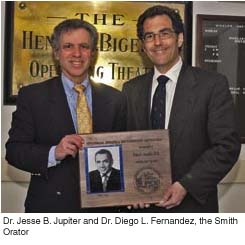 The Hand Service hosted the fifteenth annual Richard J. Smith Lectureship, in May. The academic program is dedicated to the memory of the late Richard J. Smith, MD, Founder of the Hand Service and Fellowship Program, at the MGH. This year’s offering entitled, “Kienbock’s Disease: An Ongoing Dilemma,” was presented by Diego L. Fernandez, MD, Honorary Professor of Orthopaedic Surgery, at the University of Berne. Dr. Jupiter reports, “Dr. Fernandez is an accomplished hip, upper limb, and trauma surgeon, is a member of numerous national and international societies and is a highly sought after lecturer. His contributions to our literature are numerous and extraordinary in their creativity and surgical excellence. His mastery of at least six languages has helped him develop lasting friendships throughout the world. Dr. Fernandez is a personal friend to many of us at the Massachusetts General Hospital, including the late Richard J. Smith. He is a most fitting Richard J. Smith Orator.” The Hand Service hosted the fifteenth annual Richard J. Smith Lectureship, in May. The academic program is dedicated to the memory of the late Richard J. Smith, MD, Founder of the Hand Service and Fellowship Program, at the MGH. This year’s offering entitled, “Kienbock’s Disease: An Ongoing Dilemma,” was presented by Diego L. Fernandez, MD, Honorary Professor of Orthopaedic Surgery, at the University of Berne. Dr. Jupiter reports, “Dr. Fernandez is an accomplished hip, upper limb, and trauma surgeon, is a member of numerous national and international societies and is a highly sought after lecturer. His contributions to our literature are numerous and extraordinary in their creativity and surgical excellence. His mastery of at least six languages has helped him develop lasting friendships throughout the world. Dr. Fernandez is a personal friend to many of us at the Massachusetts General Hospital, including the late Richard J. Smith. He is a most fitting Richard J. Smith Orator.”
The Hand Service continues to enjoy a large number of national and international visitors and maintains an active academic interchange. This Service continues to be one of the highlights of the Residency Training Program and it is a hallmark of excellence at the MGH.
The Harvard Shoulder Service
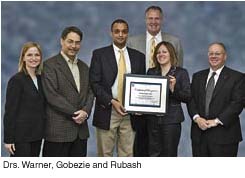 The Harvard Shoulder Service, led by Jon “J.P.” Warner, MD, continues to grow and achieve excellence on three levels; academic contributions, clinical service, and teaching initiatives. Academic highlights for this year have been the completion of a number of important research projects with recognition through acceptance to the American Academy of Orthopaedic Surgeons for presentation, as well as other meetings around the globe. One of the projects: “A Novel Method for Subscapularis Repair in Total Shoulder Replacement” was selected as one of the best Scientific Exhibits at the 2005 AAOS Annual Meeting. The exhibit presented represents an original method for improving the strength of subscapularis repair and was the brainchild of Dr. Peter Millett. The Harvard Shoulder Service, led by Jon “J.P.” Warner, MD, continues to grow and achieve excellence on three levels; academic contributions, clinical service, and teaching initiatives. Academic highlights for this year have been the completion of a number of important research projects with recognition through acceptance to the American Academy of Orthopaedic Surgeons for presentation, as well as other meetings around the globe. One of the projects: “A Novel Method for Subscapularis Repair in Total Shoulder Replacement” was selected as one of the best Scientific Exhibits at the 2005 AAOS Annual Meeting. The exhibit presented represents an original method for improving the strength of subscapularis repair and was the brainchild of Dr. Peter Millett.
As a group, Drs. JP Warner, Thomas Holovacs and Peter Millett published over 15 peer review papers, and funded more than 10 Clinical projects and 4 basic science projects. We are very excited about our collaboration with Dr. Guoan Li in our pursuit to elucidate the mechanics of shoulder arthritis, before and after arthroplasty; and Dr. Henrik Malchau is partnering with members of the Shoulder Service to perform one of the first RSA analyses of shoulder arthroplasty.
The clinical volume has continued to grow with more than 800 surgeries performed at the MGH by members of the Shoulder Service. One area of recent development has been the use of the newly developed Reverse Prosthesis to salvage failed shoulder replacements and otherwise irreparable tendon tears. Over 50 cases have been performed at the MGH with dramatic improvement in pain and function for individuals who otherwise had no alternative. The Harvard Shoulder Service has pioneered the work in this area. Dr. Holovacs reports, “Recently approved for use in the USA, the Reverse Shoulder Prosthesis is one of the most widely used prostheses in the world. Its success in Europe, especially with regard to functional results, has prompted a shift in the treatment strategies of shoulder surgeons confronted with the difficult problems of rotator cuff tear arthropathy, prosthesis revision and proximal humerus fracture sequelae in the elderly. With the availability of the Reverse Prosthesis, the old concept of “limited goal surgery” may be relegated to historical significance only.”
Educational initiatives also continue to grow. This year’s fellows, selected from a national pool of 30, included our top two choices. Our current fellows will be entering private practice at the completion of their fellowship. Dr. Todd O’Brien will be going into private practice on the North Shore and Dr. John Costouros will be returning to the Bay Area of San Francisco to private practice as well.
Dr. Peter Millett will be leaving the Service at the end of the summer to go to Vail, Colorado, to join the Steadman-Hawkins Clinic. He will be sorely missed as a surgeon, colleague and friend. We wish him well. A national search has commenced to fill his position at the BWH.
Orthopaedic Oncology Service
The Orthopaedic Oncology Service at the MGH continues to flourish under its Service Chief, Francis Hornicek, MD, PhD; Attending, Kevin Raskin, MD; and Senior Consultant, Henry Mankin, MD. The Orthopaedic Oncology Service treats patients with the most difficult problems surrounding bone and soft tissue tumors. Dr. Hornicek reports, “The Orthopaedic Oncology Service continues to serve an important role, not only in the Northeast but in the United States as a premier orthopaedic oncology service. We collaborate with Dr. Mark Gebhardt and Dr. Megan Anderson at the Beth Israel Deaconness Medical Center and Boston Children’s Hospital to provide our Fellows with an excellent training experience. The Harvard Combined Orthopaedic Oncology program is one of the best programs in the country and the only one with three ACGME slots.”
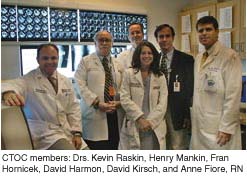 The former Connective Tissue Oncology Clinic (CTOC), a collaborative effort between the Orthopaedic Oncology Service and the MGH Cancer Center, has been renamed The Center for Sarcoma and Connective Tissue Oncology. Dr. Hornicek is the Co-Director of the team along with Dr. Thomas Delaney, of the Department of Radiation Oncology. Members of the team include clinicians from medical and radiation oncology, radiology, bone pathology and other integral medical specialties. This multidisciplinary center provides the optimal continuum of care for patients. Dr. Hornicek reports, “At the Center for Sarcoma and Connective Tissue Oncology, we take a comprehensive approach to treating rare tumors; incorporating every resource the hospital has to offer to ensure that our patients receive the best and most current treatment available.” Dr. Hornicek also noted, “In conjunction with the MGH Bone Bank, directed by William Tomford, MD, our unit has performed the world’s largest series of massive bone allograft transplants.” The former Connective Tissue Oncology Clinic (CTOC), a collaborative effort between the Orthopaedic Oncology Service and the MGH Cancer Center, has been renamed The Center for Sarcoma and Connective Tissue Oncology. Dr. Hornicek is the Co-Director of the team along with Dr. Thomas Delaney, of the Department of Radiation Oncology. Members of the team include clinicians from medical and radiation oncology, radiology, bone pathology and other integral medical specialties. This multidisciplinary center provides the optimal continuum of care for patients. Dr. Hornicek reports, “At the Center for Sarcoma and Connective Tissue Oncology, we take a comprehensive approach to treating rare tumors; incorporating every resource the hospital has to offer to ensure that our patients receive the best and most current treatment available.” Dr. Hornicek also noted, “In conjunction with the MGH Bone Bank, directed by William Tomford, MD, our unit has performed the world’s largest series of massive bone allograft transplants.”
The Sarcoma Molecular Biology Laboratory, on Jackson 11, provides ample opportunity for Dr. Hornicek to continue to develop his basic science expertise. Along with Lawrence Weissbach, PhD, MBA, Dr. Hornicek continues to explore the biological mechanisms of tumors arising in bone and soft tissues, and to turn translational research into new treatment options for patients afflicted with musculoskeletal tumors. Dr. Hornicek explains, “Our service takes pride in making it possible for our patients to live their lives to the fullest.”
Pediatric Orthopaedic Service
The Pediatric Orthopaedic Service, led by Brian Grottkau, MD, continues to expand in volume and provide specialized, integrated care to patients of the MassGeneral Hospital for Children in collaboration with Pediatric Surgery, Pediatric Medicine, the MGH Healthcare Centers, and the Boston Shriners Hospital. The Pediatric Orthopaedic Service surgeons provide backup services for the MassGeneral Hospital for Children’s Emergency Rooms at Newton-Wellesley Hospital and the North Shore Children’s Hospital. Our clinic at Newton-Wellesley Hospital continues to expand in volume as our referrals from local pediatricians continue to grow. As the patient base, outpatient visits and surgeries continue to steadily grow, we expect to expand the staff and services.
The service continues to focus on establishing a solid research program. Many projects, both basic science and clinical, are underway and have largely been funded through private foundations (as seed money), while grants are being pursued.
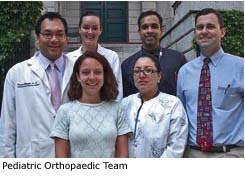 Drs. Maurice Albright and Saechin Kim are providing excellent patient care and continue to be actively involved in research projects for the children. Dr. Grottkau reports, “We have nearly reached capacity in terms of patient volume with our recurrent level of staffing and will need to expand, soon, to meet the ever-growing demand. Additionally, we have been able to set up a number of collaborative research studies with our colleagues, here, at the MassGeneral Hospital for Children, and are looking back toward a very productive year and forward to an extremely academically productive decade.” Drs. Maurice Albright and Saechin Kim are providing excellent patient care and continue to be actively involved in research projects for the children. Dr. Grottkau reports, “We have nearly reached capacity in terms of patient volume with our recurrent level of staffing and will need to expand, soon, to meet the ever-growing demand. Additionally, we have been able to set up a number of collaborative research studies with our colleagues, here, at the MassGeneral Hospital for Children, and are looking back toward a very productive year and forward to an extremely academically productive decade.”
Erin Hart, RN, MS, CPNP, continues to impress us with her academic talents and has been asked to present at numerous national nursing conferences over the past year. She had two papers accepted for the upcoming NAON conference. The MGH had one additional paper accepted for presentation, making it the hospital with the largest number of presentations at this year’s conference. Erin has been approached by NAON to take a leadership role and is presently contemplating this offer.
Sports Medicine Service
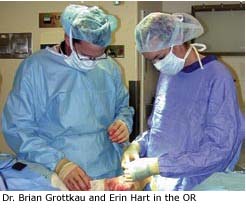 The Sports Medicine Service, under the direction of Service Chief, Bertram Zarins, MD provides specialty care for a full range of athletic injuries. The Service treats the professional and elite athletes, as well as the recreational athlete and the “weekend warrior.” The MGH Sports Medicine Service is pleased to announce that they now provide medical care to a fourth professional sports team: The World Champion Boston Red Sox. Dr. Thomas Gill was appointed Medical Director of the Red Sox, earlier this year and is responsible for not only the major league team, but the five league teams as well. We also welcome Sheryl Hassett, RN, Dr. Gill’s new nurse to the Department. The Sports Medicine Service, under the direction of Service Chief, Bertram Zarins, MD provides specialty care for a full range of athletic injuries. The Service treats the professional and elite athletes, as well as the recreational athlete and the “weekend warrior.” The MGH Sports Medicine Service is pleased to announce that they now provide medical care to a fourth professional sports team: The World Champion Boston Red Sox. Dr. Thomas Gill was appointed Medical Director of the Red Sox, earlier this year and is responsible for not only the major league team, but the five league teams as well. We also welcome Sheryl Hassett, RN, Dr. Gill’s new nurse to the Department.
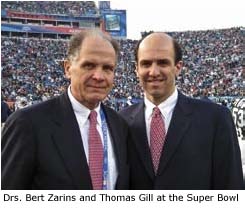 Over the past year, the members of the Service have done some groundbreaking work on in-vivo kinematic studies of the knee. They are currently in the middle of a prospective study looking at the actual in-vivo kinematics of intact versus ACL deficient knees, and will study the same patients after ACL reconstruction to see if they are normalizing the same kinematics. In the tissue-engineering realm, they are studying new cell seeded hydrogel polymers and their potential use in repair techniques for articular cartilage lesions, and cell-seeded scaffolds for meniscal repair. Over the past year, the members of the Service have done some groundbreaking work on in-vivo kinematic studies of the knee. They are currently in the middle of a prospective study looking at the actual in-vivo kinematics of intact versus ACL deficient knees, and will study the same patients after ACL reconstruction to see if they are normalizing the same kinematics. In the tissue-engineering realm, they are studying new cell seeded hydrogel polymers and their potential use in repair techniques for articular cartilage lesions, and cell-seeded scaffolds for meniscal repair.
The MGH Sports Medicine Service continues to care for the New England Patriots, now for the 23rd year. Drs. Zarins, Gill and other MGH physicians were in Jacksonville for another Super Bowl victory.
The Service also takes care of the Boston Bruins and the New England Revolution, which is in first place in Major League Soccer at the time of this writing. The Sports Medicine Service is now located on the third floor of the new YCOC. Drs. Zarins, Gill, Patel and Boland moved their offices to the YCOC in October 2004.
The MGH/Harvard Sports Medicine Fellowship is now in its 27th year. This was one of the first Sports Medicine Fellowships in the country at the time of its inception in January 1979. The three Sports Medicine Fellows who will begin in August 2005 are: Dr. Eric Berkson from Rush Presbyterian St. Luke’s Medical Center, in Chicago; Dr. Peter Asnis from The Hospital for Special Surgery in New York; and Dr. Jeremy Moses from the Harvard Combined Orthopedic Residency Program.
The Sports Medicine and Shoulder Services continue to work in close collaboration and have a combined teaching conference that takes place every Thursday morning. Physicians from various specialties present topics covering a broad range of subjects in the Sports Medicine curriculum. Dr. Zarins reports, “One of the highlights of the teaching program is a combined weekly Sports Medicine-Shoulder conference. Topics are discussed by orthopaedists, radiologists and physical therapists in an interdisciplinary approach to education.”
Orthopaedic Spine Center / Orthopaedic Spine Service
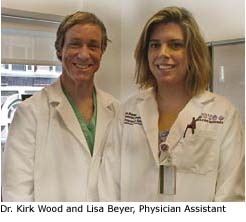 The Orthopaedic Spine Center, at the MGH, under the skillful Direction of Orthopaedic Spine Service Chief, Kirkham B. Wood, MD, is now in its sixth year. The Center continues to be responsible for the clinical, teaching and research activities related to cervical, thoracic and lumbar spine. The members of this multidisciplinary Center recently welcomed new Physiatrist, Sayed Ali Mostoufi, MD, and collaborations are expanding with Physiatry and the MGH Pain Center. Physician Assistant, Lisa Beyer (Orthopaedic Spine), and John James, RN, in the Access Program have contributed greatly to the Service’s expansion. Nearly 8,000 outpatient visits are accommodated annually. Dr. Wood notes, “Clinical and basic research are an important part of the Orthopaedic Spine Center’s mission. We have numerous clinical research investigations underway. In addition, basic science research into the care, treatment and understanding of the spinal pathology has begun in conjunction with the Orthopaedic Research Laboratories, here, at the Massachusetts General Hospital.” The Orthopaedic Spine Center, at the MGH, under the skillful Direction of Orthopaedic Spine Service Chief, Kirkham B. Wood, MD, is now in its sixth year. The Center continues to be responsible for the clinical, teaching and research activities related to cervical, thoracic and lumbar spine. The members of this multidisciplinary Center recently welcomed new Physiatrist, Sayed Ali Mostoufi, MD, and collaborations are expanding with Physiatry and the MGH Pain Center. Physician Assistant, Lisa Beyer (Orthopaedic Spine), and John James, RN, in the Access Program have contributed greatly to the Service’s expansion. Nearly 8,000 outpatient visits are accommodated annually. Dr. Wood notes, “Clinical and basic research are an important part of the Orthopaedic Spine Center’s mission. We have numerous clinical research investigations underway. In addition, basic science research into the care, treatment and understanding of the spinal pathology has begun in conjunction with the Orthopaedic Research Laboratories, here, at the Massachusetts General Hospital.”
It was a busy year for the Service whose members had numerous articles published in Spine, Journal of Spinal Disorders, and the Journal of Bone and Joint Surgery. Dr. Wood is pleased to be Co-Chairing the Scoliosis Research Society’s Committee on Adult Spinal Deformity. This summer, we will debut an Orthopaedic Spine Surgery Fellowship in conjunction with Drs. Fredrick Mansfield, Frank Pedlow and Mitchel Harris (at the BWH).
Trauma Service
The Trauma Service, under the direction of Drs. Mark Vrahas, MD, and R. Malcolm Smith, continues to grow and mature into a true sub-specialty service. They continue to see a rise in referral business from colleagues in the Partners community and the orthopaedic community at large. Per the statistics from their registry, Ortho DUDE, over 4,700 patients were entered in calendar year 2004, representing close to a 40% increase in volume over last year. This application continues to prove vital to the clinical, research, and administrative components of the practice.
Research activity reached an all-time high, this past year. Drs. Vrahas and Smith report that they are very proud that three Residents of this year’s graduating class wrote theses on a topic specific to trauma. Dr. Robert O’Toole’s thesis reviewed the largest patient cohort, to date, examining the outcomes of using the LISS plate in the fixation of tibial, femoral, and periprosthetic fractures. Dr. Pearce McCarty, reviewed outcomes in patients with intertrochanteric and subtrochanteric fractures that were fixed with the trochanteric femoral nail (TFN) system. Dr. Renn Crichlow, examined depression in the orthopaedic trauma population. Dr. Crichlow’s paper won the Jacqueline Perry Award at the 2005 Orthopaedic Rehabilitation Association Specialty Day meeting.
Drs. Vrahas and Smith report that it is clear that the consistent presence of senior level Trauma Attendings is having a significant impact on our Residents’ educational path. Drs. O’Toole and Crichlow have joined their predecessors Lisa Taitsman, MD, Ken Rodriguez, MD, and Paul Appleton, MD, in deciding to sub-specialize in Trauma and both are in the midst of their fellowships at Shock Trauma, in Baltimore.
The Trauma Service is also pleased to report that one of their junior Residents, Dr. Andy Jawa, received an $5,000.00 AO North America grant to fund a study examining the effects of transcutaneous oxygen tension on wound and soft tissue healing. Dr. Jawa plans to enroll 250 subjects across the two flagship hospitals in the hopes of determining whether this measurement would predict complications.
In addition to this unprecedented representation on Thesis Day, and Dr. Jawa’s grant, all of our attendings have had a successful year writing and applying for grants. Dr. Bhattacharyya published several papers this year, including articles about topics as varied as “Outcomes of Using a Posterior Approach in the Fixation of Posterior Shearing Tibial Plateau Fractures” (Journal Of Orthopaedic Trauma), to “Examining Evidence-Based Approaches to Reducing Malpractice Risk in Orthopaedic Surgery” (Orthopaedics), and collaborated with Dr. Vrahas and me on a project to “Understand the Value of a Dedicated Orthopaedic Trauma Operating Room” (Journal Of Trauma). Dr. Bhattacharyya also received two Innovation Awards from the MGH Ventures Committee to fund the prototype and production of a state-of-the-art depth gauge and a femoral stem inserter to reduce the incidence of periprosthetic fractures.
All of the Partners Orthopaedic Trauma Service’s attendings were very busy this year presenting papers, and leading meetings and courses all over the world. Dr. Smith went on a three-country tour of South America (Peru, Ecuador, and Chile), chaired an AO course in the UK, and chaired the Masters Course in Davos, Switzerland. Dr. Vrahas gave an invited lecture at the Annual Meeting of the American College of Surgeons, in New Orleans. The lecture was given at a symposium addressing problems facing trauma centers in the new millennium. While the general surgeons and neurosurgeons painted bleak outlooks, Dr. Vrahas pointed out that, “Proper organization could make trauma enjoyable for the specialists and the residents, and valuable to the department and hospital.” He also said he was very proud to present the many successes of the Partners program.
Drs. Mark Vrahas and Jesse Jupiter led another successful New England Fracture Forum held, this year, in Stowe, VT. This meeting has become an important tradition for regional surgeons, and continues to generate national interest as well. This meeting generated so much interest that AO North America has taken over its operation and has begun franchising the meeting around the country. The 2006 meeting will return to Stowe.
The Trauma Service was pleased to host several visiting scholars throughout the year. They hosted students, residents, and attendings from all corners of the world including Australia, England, China, and Austria. The Trauma Service has experienced an increased interest in their visiting fellowship program from Chinese and Korean orthopaedic surgeons. This year, they hosted two surgeons: Dr. Fu Zhonnguo and Dr. Yun Tian from the People’s Hospital, in Beijing, who made great impacts on the program. Dr. Smith, in fact, is headed to Beijing, this spring, to present to their colleagues. Dr. Smith reports, “We are pleased by this international interest and look forward to meeting more colleagues from around the world.”
Administratively, Suzanne Morrison, MPH, accepted an offer to become the Trauma Service’s first Administrative Manager, at MGH. Suzanne’s chief responsibility is to work with Drs. Vrahas, Smith, and Bhattacharyya to better integrate the outpatient clinic into the service as a whole. While she will continue many of her Partners shared initiative responsibilities, she will work with her fellow MGH colleagues to develop and standardize policies and procedures to improve operational efficiency.
RESEARCH UPDATES:
Orthopaedic Biomechanics and Biomaterials Laboratory (OBBL)
The Orthopaedic Biomechanics and Biomaterials Laboratory (OBBL), led by Co-Directors Orhun Muratoglu, PhD, and Henrik Malchau, MD, PhD, continues to play a significant role in total joint arthroplasty research with many innovative contributions. The OBBL pioneered in fields of cementing techniques, hip and knee implant design, revision total hip arthroplasty techniques, biology of bone in growth, load bearing surface applications in total joints (such as the first and second generation highly crosslinked polyethylenes) and also in the area of hydrogels for joint applications.
Currently, there are a number of clinical studies underway at the OBBL. One of these, in its fourth year, utilizes the radiostereometric analysis (RSA) technique to determine the wear behavior of a first generation highly crosslinked polyethylene in conjunction with large head femoral components. The data is already showing a marked reduction in the femoral head penetration. In addition, another clinical follow-up study, with a larger patient population in its sixth year, is showing no detectible periprosthetic osteolysis.
The OBBL is also focusing on novel crosslinked polyethylenes with low wear and high fatigue strength for applications in high-stress total knee replacements. Under the direction of Dr. Muratoglu, the team has added two new inventions to their already strong intellectual property portfolio: two novel methods of improving the fatigue resistance of highly crosslinked polyethylenes, the first uses using mechanical annealing and the second uses vitamin-E to stabilize the residual free radicals and plasticize the base polymer. Both of these technologies were licensed to implant manufacturers and will be in clinical use within the next few years.
In addition, the laboratory is collaborating with Dr. Kirk Wood to identify research focus areas in the spine. The team has already identified a hydrogel technology for nucleoplasty of the intervertabral disc; human cadaver studies are underway. Dr. Hatice Bodugoz-Senturk has joined the team, as a postdoctoral fellow, this year, to work on the development of alternative therapies for nuclear augmentation using synthetic hydrogels.
On an annual basis, the Laboratory brings in over $3 million in funding from a variety of sources: government, foundations, and industrial. Congratulations to Dr. Muratoglu and team for their new CIMIT Proof-of-Concept Grant; “Warm Irradiation and Tocopherol Stabilization of a High-Pressure Crystallized UHMWPE for Total Knees.” The OBBL is over flowing with new activity and energy. The skillful scientists in the lab had a phenomenal year at the ORS/AAOS with 17 podium, poster, and scientific exhibits. Congratulations to the members of the OBBL on these outstanding accomplishments!
Biomaterials Laboratory
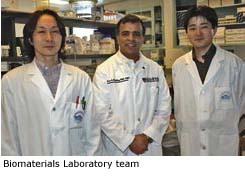 The Biomaterials Laboratory team members are constantly pushing the envelope to identify new technologies to enhance our understanding of osteolysis in total joint replacements. Guided by Arun Shanbhag, PhD, MBA, researchers in the Biomaterials Laboratory have profiled the expression of nearly 15,000 genes associated with osteolysis and aseptic loosening. Using a variety of bioinformatics tools such as cluster analysis and principal component analysis, we have confirmed the role of many genes and identified yet novel genes up-regulated as a consequence of the biomaterial interaction. These data are cross-referenced to protein analysis from osteolytic samples, using high-throughput protein chips, and permits us to dissect the molecular mechanisms of osteolysis. The Biomaterials Laboratory team members are constantly pushing the envelope to identify new technologies to enhance our understanding of osteolysis in total joint replacements. Guided by Arun Shanbhag, PhD, MBA, researchers in the Biomaterials Laboratory have profiled the expression of nearly 15,000 genes associated with osteolysis and aseptic loosening. Using a variety of bioinformatics tools such as cluster analysis and principal component analysis, we have confirmed the role of many genes and identified yet novel genes up-regulated as a consequence of the biomaterial interaction. These data are cross-referenced to protein analysis from osteolytic samples, using high-throughput protein chips, and permits us to dissect the molecular mechanisms of osteolysis.
The laboratory has diverse skill sets, which complement the various ongoing studies. Dr. Koichiro Hayata, from Tokyo Women’s Medical University Hospital, is defining the effect of bisphosphonates on osteoblast-osteoclast interactions, particularly in stimulating osteoclastogenesis. Later in the summer, Dr. Hayata returns to his clinical duties as an arthroplasty surgeon at the University Hospital. Dr. Masayuki Kawashima from Oita University (Japan) is investigating the biological mechanisms of osteolysis in our laboratory. Together, Drs. Hayata and Kawashima are collaborating with Arthroplasty Fellows, Drs. James Huddleston and John Velyvis, in using high-throughput protein profiling biochips to understand the sequence of cytokines and mediators released by macrophages when they interact with wear debris. Grant Garrigues, a medical student at Harvard Medical School, has completed key studies in defining the transcription profile of osteolysis. Mr. Garrigues will be continuing his Orthopaedic Surgery Residency at Duke University Medical Center. Manish Sethi, also a Harvard Medical School student, working in our laboratory, will continue his Orthopaedic training, here, in the Combined Harvard Orthopaedic Residency Program. In our studies, Dr. Lawrence Weissbach, Director of the Molecular Sarcoma Laboratory, provides much needed molecular biology expertise. We all greatly appreciate the many contributions of the Biomaterials Laboratory.
Bioengineering (Robotics) Laboratory
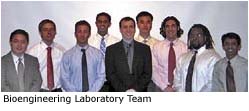 Guoan Li, PhD, Laboratory Director, and members of the Bioengineering Laboratory, have extended their dual-orthogonal fluoroscopic imaging technique for accurate measurement of in-vivo musculoskeletal joint kinematics. In-vivo MRI, combined with 3D fluoroscopy studies and robotic testing, are being utilized to provide baselines for the development of new concepts in total knee arthroplasty, unicompartmental knee arthroplasty, anterior and posterior cruciate ligament research, and studies of the in-vivo function of the lower and upper extremities. There are several Robotic Teams: Sports Medicine, Hand and Upper Extremity, Joint Kinematics, and Total Joint (including unicompartmental) Arthroplasty. Four new In-vivo Kinematic Teams have been recently formulated: In-vivo Knee Arthroplasty, In-vivo Cruciate Reconstruction, In-vivo Shoulder, and In-vivo Ankle. These research teams are utilizing the robotic testing system, and advanced imaging techniques, to develop new concepts in the understanding of musculoskeletal joint functions, injury mechanisms, and efficiency of surgical modalities. Guoan Li, PhD, Laboratory Director, and members of the Bioengineering Laboratory, have extended their dual-orthogonal fluoroscopic imaging technique for accurate measurement of in-vivo musculoskeletal joint kinematics. In-vivo MRI, combined with 3D fluoroscopy studies and robotic testing, are being utilized to provide baselines for the development of new concepts in total knee arthroplasty, unicompartmental knee arthroplasty, anterior and posterior cruciate ligament research, and studies of the in-vivo function of the lower and upper extremities. There are several Robotic Teams: Sports Medicine, Hand and Upper Extremity, Joint Kinematics, and Total Joint (including unicompartmental) Arthroplasty. Four new In-vivo Kinematic Teams have been recently formulated: In-vivo Knee Arthroplasty, In-vivo Cruciate Reconstruction, In-vivo Shoulder, and In-vivo Ankle. These research teams are utilizing the robotic testing system, and advanced imaging techniques, to develop new concepts in the understanding of musculoskeletal joint functions, injury mechanisms, and efficiency of surgical modalities.
Congratulations to. Guoan Li, PhD; Thomas Gill, MD; Louis DeFrate, PhD; Jeremy Moses; MD, Ramprasad Papannagari and Lewis Shi for a newly awarded R01 research project from NIH which has teamed up bioengineers and clinicians to explore the in-vivo biomechanism that causes cartilage degeneration after PCL rupture. This research will fully utilize the advanced dual-orthogonal fluoroscopic and MR imaging techniques to quantify the alternation of articular cartilage contact mechanics after PCL injury.
The laboratory recently celebrated the attainment of Dr.Louis DeFrate’s PhD and Janine Pierce’s MS degree in Mechanical Engineering at MIT. Dr. DeFrate has been an integral member of the laboratory since 1999, and concentrated on the experimental and theoretical modeling of the knee and soft tissue biomechanics. Ms. Pierce joined the laboratory in 2001, and has been developing a global converging optimization method to accurately predict in-vivo muscle contraction forces and joint reaction forces of musculoskeletal systems. Jeremy Suggs, an MIT graduate student, joined the laboratory in 2000 and is studying the mechanisms of treating the osteoarthritic knee using unicompartmental knee arthroplasty. Lu Wan and Jeffrey Bingham, two MIT graduate students, joined the laboratory, in 2004. Mr. Wu has been studying the in-vivo ankle joint kinematics and in-vivo articular cartilage contact mechanics. Mr. Bingham has been developing an optimal auto-matching algorithm for the dual-orthogonal fluoroscopic imaging system. Ramprasad Papannagari and George Hanson, two young bioengineers, have actively participated in a variety of clinical and robotic projects, including in-vivo ACL, in-vivo TKA as well as in-vivo shoulder investigations. Dr. Patrick Boyer, an Orthopaedic Surgeon, from France, has developed an exciting in-vivo shoulder model. The team had over 20 podium, posters and symposiums at this year’s ORS and AAOS meetings and published extensively in various orthopaedic and biomedical journals.
Cartilage Biology and Orthopaedic Oncology
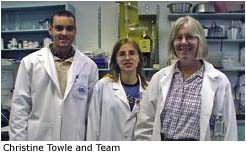 The Cartilage Biology and Orthopaedic Oncology Laboratories are under the direction of Drs. Christine A. Towle and Henry J. Mankin. Dr. Towle’s research team is exploring the mechanisms that regulate metabolism in normal articular cartilage; aberrations in these mechanisms may lead to cartilage damage in pathological conditions such as osteoarthritis. In particular, the group is interested in understanding the soluble and mechanical factors that regulate the integrity of the articular cartilage in both health and disease. They are beginning to dissect the roles that the various components of static or invariant mechanical compression play in decreasing extracellular matrix synthesis in articular cartilage. The laboratory recently demonstrated that osmotic stress, a component of static mechanical compression, acts synergistically with interleukin-1 to stimulate the production of COX-2 and prostaglandin E2. A grant from the National Institute of Aging supports this investigation of the role of IL-1 in mechanical signal transduction. The Cartilage Biology and Orthopaedic Oncology Laboratories are under the direction of Drs. Christine A. Towle and Henry J. Mankin. Dr. Towle’s research team is exploring the mechanisms that regulate metabolism in normal articular cartilage; aberrations in these mechanisms may lead to cartilage damage in pathological conditions such as osteoarthritis. In particular, the group is interested in understanding the soluble and mechanical factors that regulate the integrity of the articular cartilage in both health and disease. They are beginning to dissect the roles that the various components of static or invariant mechanical compression play in decreasing extracellular matrix synthesis in articular cartilage. The laboratory recently demonstrated that osmotic stress, a component of static mechanical compression, acts synergistically with interleukin-1 to stimulate the production of COX-2 and prostaglandin E2. A grant from the National Institute of Aging supports this investigation of the role of IL-1 in mechanical signal transduction.
The Oncology group continues to focus on clinical, molecular, and biochemical markers that may serve as predictors of metastasis in bone and soft tissue tumors. Recent research demonstrated that while COX-2 is not expressed in benign cartilage tumors, it is expressed in about half of malignant chondrosarcomas. They continue to assess DNA synthesis; their our series. The laboratories have access to a computerized database with information on almost 17,000 patients treated by the Orthopaedic Oncology Service including 1200 treated with allograft transplantation. This data has been used in numerous clinical studies.
Henry Jaffe MD and Crawford Campbell, MD, bequethedto Dr. Mankin their entire pathology collections consisting of thousands of cases, which include histologic slides, x-ray films, and patient records. Dr. Mankin obtained a grant from the Orthopaedic Research and Education Foundation (OREF) to convert this incredible resource into a digital format for educational purposes. Corporate funding and donations from patients and their families, further support Dr. Mankin’s clinical research projects.
The work of the Cartilage Biology Laboratories, as well as the Oncology Laboratory, is supported by a long history of NIH funding. Finally, congratulations to Dr. Towle for her recent promotion to Assistant Professor at the Harvard Medical School.
Sarcoma Molecular Biology Laboratory
The Sarcoma Molecular Biology Laboratory (SMBL), under the direction of Francis J. Hornicek, MD, PhD, Chief of Orthopaedic Oncology, at Massachusetts General Hospital, and Lawrence Weissbach, PhD, MBA, Assistant Professor of Biochemistry, are investigating novel approaches to further advance the treatment of bone sarcomas. The overall objectives of this laboratory are to explore biological mechanisms of tumors arising in bone and perform translational research into new treatment options for sarcoma patients. The SMBL is currently focusing on antiangiogenesis and chemotherapeutic drug resistance, with the goal of delaying, and possibly preventing, sarcoma growth and metastasis. Chemoresistance is a formidable obstacle in treating patients afflicted with certain types of sarcomas such as chondrosarcoma, for which treatment options are limited. In collaboration with colleagues in Italy, two cancer cell lines derived from different tumor types that display drug resistance to the promising marine chemotherapeutic Ecteinasciden-743 (ET-743; currently being tested for efficacy in clinical trials) were subjected to gene microarray analysis to identify genes altered in their expression as compared to their corresponding parent cell lines. Only a handful of genes exhibited common changes in the two drug-resistant cell lines, suggesting that these genes may play a role in mediating the chemoresistance of cancer cell lines to the ET-743.
Drs. Lawrence Weissbach and Arun Shanbhag are collaborating on molecular mechanisms underlying bone deterioration around total joint replacements. This clinical osteolysis has been attributed to various cell types and cytokines. The Biomaterials Laboratory, under the direction of Dr. Shanbhag, has made important contributions to this area of research. Dr. Weissbach states that, “I am enthusiastic about collaborating with Drs. Shanbhag and Rubash on this important unmet medical need. I hope to apply various techniques in molecular biology and protein biochemistry to advance these studies.”
The Sarcoma Molecular Biology Laboratory has published numerous articles pertaining to sarcoma biology, and has received funding from a variety of sources including foundations, corporate sponsors, and benefactors.
Laboratory of Orthopaedic Biochemistry and Osteoarthritis
Teresa Morales, PhD, directs the Laboratory of Orthopaedic Biochemistry and Osteoarthritis Therapy. Dr. Morales serves on many NIH panels, and is presently a member of the Arthritis, Connective Tissue and Skin study section. She explains, “The global mission of the Laboratory is to understand the regulation of chondrocyte biology and to apply this knowledge towards investigations of cartilage repair.” Presently, Dr. Morales and her team are examining how normal regulatory pathways are altered during osteoarthritis (OA) to culminate in progressive matrix degradation, and we have clues indicating that the Insulin-like growth factor binding proteins (particularly IGFBP-3) play a key role in the dysregulation of matrix metabolism of OA. Another goal is to understand chondrocyte migration and to develop new avenues of cartilage repair. They have recently examined chondrocyte migration through three-dimensional collagen gels, since the latter provide a very simple model for cell migration through tissue lattices. Interestingly, Dr. Morales notes, “Insulin-like growth factors stimulate motility, which is consistent with its role as a positive cartilage effector. This work has recently led us to examine metalloproteases and their inhibitors, since we think these enzymes aid cell locomotion through 3D lattices.”
Recent members of the laboratory include Ms. Blair Smith, BS, in Biomedical Engineering (Brown University), who is currently completing pre-med requirements at Harvard Extension School, and Dr. Tiezheng Sun, Ph.D. (Clinical Immunology, Arthritis Institute, Beijing University) who joined the Laboratory last fall as a postdoctoral fellow. Key collaborators with Dr. Morales include: Dr. Ernst Hunziker, Director Muller Institute of Biomechanics; Dr. Douglas Lauffenburger, Director, Division of Biological Engineering, MIT; and, most recently, Dr. Hideaki Nagase from the Kennedy Institute of Rheumatology (Imperial College, London). The Laboratory’s funding includes an R01 grant from the NIH. Congratulations to Dr. Morales for her noteworthy accomplishments!
Laboratory for Musculoskeletal Engineering
The Laboratory for Musculoskeletal Tissue Engineering, under the direction of Mark Randolph and Dr. Thomas Gill, focuses on cartilage repair and regeneration in the knee. Work over the past two years, funded by the AO Foundation, continued on tissue engineering strategies to repair lesions in the avascular regions of the meniscus. Results presented at the Orthopedic Research Society (ORS), in San Francisco, and the International Cartilage Repair Society, in Ghent, Belgium, demonstrated an efficient means to seed chondrocytes onto polygalactin (PLGA) scaffolds, and the capacity of these cell-scaffold constructs to heal bucket-handle lesions in swine meniscus. Furthermore, the swine studies showed that allogeneic chondrocytes were as effective as autologous cells in repairing these lesions. A new collaborative agreement with the Genzyme Corporation is exploring new scaffold materials and cell types for meniscal repair and regeneration. Dr. Giuseppe Peretti, from San Raffaele Hospital, in Milan, Italy, has been a long-time contributor to this work and continues to collaborate on these studies. In fact, one of their recent articles, “Cell-Based Therapy for Meniscal Repair: A Large Animal Study,” was the winner of the 2005 Hughston Award for the most outstanding paper in the American Journal of Sports Medicine in 2004. This work was presented at the American Orthopaedic Society for Sports Medicine’s meeting in Keystone, Colorado in July.
Mark Randolph’s group continues to explore alternative cell sources and new hydrogels for articular cartilage repair and regeneration. Work published over the past year reports on the cartilage-forming capability of chondrocytes from the ear and the ribs. An additional study collaborating with Dr. Lawrence Bonassar, from Cornell University, examined the ability of these types of chondrocytes to integrate and heal cartilage disks together, with increasing strength over time. A collaboration with Dr. Kristi Anseth, at the University of Colorado, is exploring photoactive substances that can form hydrogel scaffolds for cartilage formation.
As part of collaborations between Dr. Gill and Drs. Robert Redmond and Irene Kochevar, in the MGH Wellman Center for Photomedicine, Dr. Shinichi Ibusuki, from Kyushu University, Japan, is studying new photoreactive compounds that can form hydrogels to encapsulate chondrocytes for cartilage formation. Their work on photo tissue bonding (PTB) in collagen-rich tissues is the basis for generating new collagen-based hydrogels for cartilage repair and regeneration.
Biomotion Laboratory
The Biomotion Laboratory, in Ruth Sleeper Hall, is directed by David E. Krebs, DPT, PhD. Dr. Krebs teaches advanced statistics to graduate students and holds academic appointments in the Department of Orthopaedic Surgery, at Harvard Medical School, and in the Mechanical Engineering Department at MIT.
Dr. Krebs explains, “The mission of the MGH Biomotion Laboratory is to better understand the biomechanical and neural constraints of human movement. The major goals are to investigate the means by which, body segment kinematics and kinetics are governed by neuropathic and arthropathic conditions. Our objectives include determining the means by which humans compensate for, and adapt to, specific orthopaedic and neurophysiological motor deficits. We employ state-of-the-art modeling, theory and data acquisition to generate appropriately detailed analyses of impairments (organ level function or dysfunction), functional limitations, and whole person function or dysfunction, as well as medical imaging techniques such as MRI to quantify the internal derangement of the joints and body segments. We recently acquired, and validated, a wearable motion detection system that patients wear for up to a week. The device classifies over 45 different activities (e.g., walking, climbing stairs) and records joint motions 32 times a second – even while sleeping!” We look forward to collaborations with Dr. Krebs and his team and our MIS Team.
Department Holiday Party
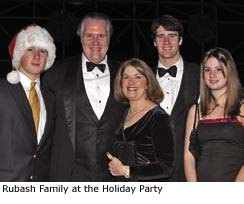 This year’s gala black-tie Department Holiday Party was held at the John F. Kennedy Presidential Library and Museum. We had a fantastic turnout by members of the Department with nearly 400 guests enjoying the evening’s festivities. Victorian carolers greeted attendees as they entered the museum. The exhibits were open for viewing including a special exhibit, “Presents for a President and First Lady,” a display of 65 state gifts presented to President and Mrs. Kennedy by foreign leaders from around the globe. During the cocktail hour, guests were treated to a running video montage of the YCOC’s construction and our office’s move, produced by the Department’s Clinical Research Editor, Karen M. Bernstein. The Museum’s gourmet caterers produced a wonderful dinner buffet, which was followed by dancing to the lively sounds of a DJ. Everyone had an incredible evening and it was a wonderful way to start the holiday season. Preparations are already underway for this year’s spectacular event, which will be held at the Museum of Fine Arts. This year’s gala black-tie Department Holiday Party was held at the John F. Kennedy Presidential Library and Museum. We had a fantastic turnout by members of the Department with nearly 400 guests enjoying the evening’s festivities. Victorian carolers greeted attendees as they entered the museum. The exhibits were open for viewing including a special exhibit, “Presents for a President and First Lady,” a display of 65 state gifts presented to President and Mrs. Kennedy by foreign leaders from around the globe. During the cocktail hour, guests were treated to a running video montage of the YCOC’s construction and our office’s move, produced by the Department’s Clinical Research Editor, Karen M. Bernstein. The Museum’s gourmet caterers produced a wonderful dinner buffet, which was followed by dancing to the lively sounds of a DJ. Everyone had an incredible evening and it was a wonderful way to start the holiday season. Preparations are already underway for this year’s spectacular event, which will be held at the Museum of Fine Arts.
Annual Children's Holiday Party
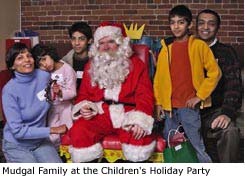 We held our fifth Annual Children’s Holiday Party at the Children’s Museum. Nearly 100 family members joined us, this year, for an afternoon filled with smiles and lots of fun. The afternoon’s events included lunch, followed by a holiday cake and ice cream in one of the Museum’s private function rooms. Santa and his elves, as well as a storyteller and musician, were there to provide entertainment to the group. Each child received a goody bag and toy gift. Michelle Rose, from MGH Photography, was onsite to take pictures of each child with Santa and his elves. Thank you to Nick Avalone, MD, PGY 4, who worked with our staff to create a magical time for everyone. We held our fifth Annual Children’s Holiday Party at the Children’s Museum. Nearly 100 family members joined us, this year, for an afternoon filled with smiles and lots of fun. The afternoon’s events included lunch, followed by a holiday cake and ice cream in one of the Museum’s private function rooms. Santa and his elves, as well as a storyteller and musician, were there to provide entertainment to the group. Each child received a goody bag and toy gift. Michelle Rose, from MGH Photography, was onsite to take pictures of each child with Santa and his elves. Thank you to Nick Avalone, MD, PGY 4, who worked with our staff to create a magical time for everyone.
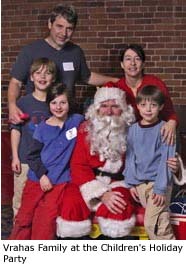
Personal Note
The winter of 2003 was the second coldest in recorded weather history. The winter 2004 created some of the largest snowfalls ever in New England. What could be next? Fortunately however, as I write this the days are now longer, the sun is higher in the sky, and we had a wet, yet beautiful, spring.
This year has been one filled with incredible emotions for me. The move to the YCOC and the consolidation of most of the Department under one roof has been a tremendous opportunity for us to develop a more cohesive Orthopaedics Department. Our patients’ experiences have been wonderful and I am so pleased that the move and transition was a smooth one. Thank you, David Gaynor, and our staff.
My wife, Kimberly, and I celebrated the high school graduation of our first child, Brad on June 3rd. Coincidentally, Brad’s eighteenth birthday fell on his graduation day. Brad was fortunate to contribute to the Weston High School Swim Team that won the State Championship in 2005. He has decided to swim in college and we look forward to seeing him combine academics with collegiate athletics at Rollins College in Florida.
Our younger son, Steven, has just finished his junior year at Weston High School and will soon begin looking at colleges as well. He had a remarkable season of wrestling in the 189-pound weight class. He has already decided that he would like to wrestle in college and we are preparing him for his academics and athletics as well.
Our Kristin just finished 9th grade. She made the transition from the Weston Middle School to the High School without difficulty. She is a wonderful student and a bright young lady. Kristin continues to compete in equestrian events, locally and throughout the North East. We look forward to an improvement in her health and a return to her activities.
Kimberly and I have greatly enjoyed our six years in New England. The time has been extremely rewarding for our family and we look forward to the next five years as our children transition from high school to college.
Finally, I am pleased to be a member of such a wonderful and world-class Orthopaedic department, at the MGH. Our clinical divisions and research laboratories continue to excel and it is a pleasure to help facilitate the growth and solidarity of our Department. It is a distinct honor and pleasure for me to be your Chairman.
|